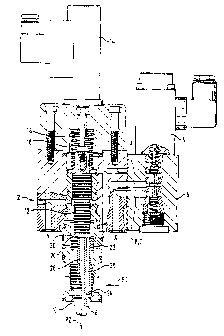Some of the information on this Web page has been provided by external sources. The Government of Canada is not responsible for the accuracy, reliability or currency of the information supplied by external sources. Users wishing to rely upon this information should consult directly with the source of the information. Content provided by external sources is not subject to official languages, privacy and accessibility requirements.
Any discrepancies in the text and image of the Claims and Abstract are due to differing posting times. Text of the Claims and Abstract are posted:
| (12) Patent: | (11) CA 2054367 |
|---|---|
| (54) English Title: | ADJUSTABLE PROPORTIONAL THROTTLE-VALVE WITH FEEDBACK |
| (54) French Title: | SOUPAPE D'ETRANGLEMENT REGLABLE A DEPLACEMENT PROPORTIONNEL AVEC RETROACTION |
| Status: | Expired and beyond the Period of Reversal |
| (51) International Patent Classification (IPC): |
|
|---|---|
| (72) Inventors : |
|
| (73) Owners : |
|
| (71) Applicants : |
|
| (74) Agent: | GOWLING WLG (CANADA) LLP |
| (74) Associate agent: | |
| (45) Issued: | 2001-12-25 |
| (22) Filed Date: | 1991-10-28 |
| (41) Open to Public Inspection: | 1992-05-01 |
| Examination requested: | 1998-08-24 |
| Availability of licence: | N/A |
| Dedicated to the Public: | N/A |
| (25) Language of filing: | English |
| Patent Cooperation Treaty (PCT): | No |
|---|
| (30) Application Priority Data: | ||||||
|---|---|---|---|---|---|---|
|
The throttle-part of the valve comprises a two-way seat valve with a follow-up
throttle
piston. A differential guide piston allows to position the follow-up throttle
piston via an edge
control system. The differential guide piston is biased via a spring in a
pressure-spring
compartment in the direction of the closed position of the edge control
system. A proportional
directional control valve, which is actuated by a magnet, allows to pressurise
or depressurise the
pressure-spring compartment via a pilot line A, whilst the position of the
guide piston is
determined by an inductive displacement transducer.
Note: Claims are shown in the official language in which they were submitted.
Note: Descriptions are shown in the official language in which they were submitted.

2024-08-01:As part of the Next Generation Patents (NGP) transition, the Canadian Patents Database (CPD) now contains a more detailed Event History, which replicates the Event Log of our new back-office solution.
Please note that "Inactive:" events refers to events no longer in use in our new back-office solution.
For a clearer understanding of the status of the application/patent presented on this page, the site Disclaimer , as well as the definitions for Patent , Event History , Maintenance Fee and Payment History should be consulted.
| Description | Date |
|---|---|
| Time Limit for Reversal Expired | 2006-10-30 |
| Inactive: IPC from MCD | 2006-03-11 |
| Inactive: IPC from MCD | 2006-03-11 |
| Letter Sent | 2005-10-28 |
| Inactive: Late MF processed | 2002-10-31 |
| Grant by Issuance | 2001-12-25 |
| Inactive: Cover page published | 2001-12-24 |
| Inactive: Final fee received | 2001-09-25 |
| Pre-grant | 2001-09-25 |
| Notice of Allowance is Issued | 2001-06-26 |
| Notice of Allowance is Issued | 2001-06-26 |
| Letter Sent | 2001-06-26 |
| Inactive: Approved for allowance (AFA) | 2001-06-14 |
| Amendment Received - Voluntary Amendment | 2001-03-14 |
| Inactive: S.30(2) Rules - Examiner requisition | 2000-09-20 |
| Inactive: Application prosecuted on TS as of Log entry date | 1998-09-28 |
| Letter Sent | 1998-09-28 |
| Inactive: Status info is complete as of Log entry date | 1998-09-28 |
| All Requirements for Examination Determined Compliant | 1998-08-24 |
| Request for Examination Requirements Determined Compliant | 1998-08-24 |
| Application Published (Open to Public Inspection) | 1992-05-01 |
There is no abandonment history.
The last payment was received on 2001-10-03
Note : If the full payment has not been received on or before the date indicated, a further fee may be required which may be one of the following
Patent fees are adjusted on the 1st of January every year. The amounts above are the current amounts if received by December 31 of the current year.
Please refer to the CIPO
Patent Fees
web page to see all current fee amounts.
| Fee Type | Anniversary Year | Due Date | Paid Date |
|---|---|---|---|
| MF (application, 6th anniv.) - small | 06 | 1997-10-28 | 1997-10-21 |
| Request for examination - small | 1998-08-24 | ||
| MF (application, 7th anniv.) - small | 07 | 1998-10-28 | 1998-09-30 |
| MF (application, 8th anniv.) - small | 08 | 1999-10-28 | 1999-10-27 |
| MF (application, 9th anniv.) - small | 09 | 2000-10-30 | 2000-08-21 |
| Final fee - small | 2001-09-25 | ||
| MF (application, 10th anniv.) - small | 10 | 2001-10-29 | 2001-10-03 |
| Reversal of deemed expiry | 2003-10-28 | 2002-10-31 | |
| MF (patent, 11th anniv.) - small | 2002-10-28 | 2002-10-31 | |
| Reversal of deemed expiry | 2003-10-28 | 2003-10-02 | |
| MF (patent, 12th anniv.) - small | 2003-10-28 | 2003-10-02 | |
| 2004-10-04 | |||
| MF (patent, 13th anniv.) - small | 2004-10-28 | 2004-10-04 |
Note: Records showing the ownership history in alphabetical order.
| Current Owners on Record |
|---|
| HYDROLUX S.A.R.L. |
| Past Owners on Record |
|---|
| HANS SCHWELM |